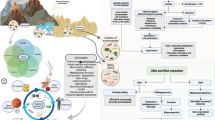Abstract
Lithopanspermia is a theory proposing a natural exchange of organisms between solar system bodies as a result of asteroidal or cometary impactors. Research has examined not only the physics of the stages themselves but also the survival probabilities for life in each stage. However, although life is the primary factor of interest in lithopanspermia, this life is mainly treated as a passive cargo. Life, however, does not merely passively receive an onslaught of stress from surroundings; instead, it reacts. Thus, planetary ejection, interplanetary transport, and planetary entry are only the first three factors in the equation. The other factors are the quality, quantity, and evolutionary strategy of the transported organisms. Thus, a reduction in organism quantity in stage 1 might increase organism quality towards a second stress challenge in stage 3. Thus, robustness towards a stressor might in fact be higher in the bacterial population surviving after transport in stage 3 than at the beginning in stage 1. Therefore, the stages of lithopanspermia can themselves facilitate evolutionary processes that enhance the ability of the collected organisms to survive stresses such as pressure and heat shock. Thus, the multiple abiotic pressures that the population encounters through the three stages can potentially lead to very robust bacteria with survival capacities considerably higher than might otherwise be expected. This analysis details an outcome that is possible but probably rare. However, in addition to lithopanspermia, spacecraft mediated panspermia may also exist. The analogous stages in a spacecraft would result in a greater likelihood of increasing the stress tolerance of hitchhiking organisms. Furthermore, missions seeking life elsewhere will frequently be sent to places where the possibility of life as we know it is assumed to exist. Thus, we not only can transport terrestrial organisms to places where they are potentially more likely to survive but also may increase their invasive potential along the way. This analysis highlights further requirements that planetary protection protocols must implement and also provides a framework for analyses of ecological scenarios regarding the transmission of life, natural or artificial, between worlds in a solar system.


Similar content being viewed by others
Notes
Of course, if they can remain active in the environment of the meteorite, and the transmission lasts long enough, then the bacterial population can eventually evolve traits that remove robust genotypes towards pressure and heat shock, and instead confer genotypes robust towards other stressors. Here, for simplicity's sake, they are assumed to maintain their robust genotypes towards pressure and heat shock.
References
Artsutanov Y (1960) Kosmos na electrovoze. Komsomolskaya Pravda, New York
Bahrndorff S, Marien J, Loeschke V, Ellers J (2009) Dynamics of heat-induced thermal stress resistance and Hsp70 expression in the springtail, Orchesella cincta. Funct Ecol 23:233–239
Beech M, Coulson IM, Comte M (2018) Lithopanspermia: the terrestrial input during the past 550 million years. Am J Astron Astrophys 6(3):81–90
Brennecka GALE, Borg MW (2014) Insights into the Martian mantle: the age and isotopics of the meteorite fall Tissint. Meteorit Planet Sci 49(3):412–418
COSPAR Planetary Protection Policy (2019). https://cosparhq.cnes.fr/assets/uploads/2019/07/PPP_SRT-Article_Role-Structure_Aug-2019.pdf.
de Montlivault L (1821) Comte Eleonore-Jacques-Francois: conjectures sur la réunion de la lune à la terre, et des satellites en général à leur planète principale... par un ancien officier de marine. Reliure inconnue, Paris
Eagon RG (1962) Psedomonas natrigens, a marine bacterium with a generation time of less than 10 minutes. J Bacteriol 83(4):736–737
Farmer JD, Bell JF, Benison KC, Boynton WV, Cady SL, Ferris FG, MacPherson D, Race MS, Thiemens MH, Wadhwa M (2009) Assessment of planetary protection requirements for Mars sample return missions. National Academies Press, Cambridge
Ferrer M, Chernikova TN, Yakimov MM, Golyshin PN, Timmis KN (2003) Chaperonins govern growth of Escherichia coli at low temperatures. Nat Biotechnol 21:1266–1267
Gayán E, Govers SK, Michiels CW, Aertsen A (2016) Severely heat injured survivors of E. coli O157:H7 ATCC 43888 display variable and heterogeneous stress resistance behavior. Front Microbiol. https://doi.org/10.3389/fmicb.2016.01845
Gibson B, Wilson DJ, Feil E, Eyre-Walker A (1880) The distribution of bacterial doubling times in the wild. Proc Biol Sci 2018(285):20180789
Horneck G, Stöffler D, Ott S, Hornemann UC, Charles SM, Ralf M, de Vera Cornelia J-PF, Jörg Schade S, Artemieva NA (2008) Microbial rock inhabitants survive hypervelocity impacts on mars-like host planets: first phase of lithopanspermia experimentally tested. Astrobiology 8:1
Irving T (2021) http//www.imca.cc/mars/martian-meteorites-list.htm
Jaakkola ST, Ravantti J, Oksanen HM, Bamford DH (2016) Buried alive: microbes from ancient halite. Trends Microbiol Rev 24(2):148–160
Johnson EA (2002) Microbial adaptation and survival in foods. In: Yousef AE, Juneja VK (eds) Microbial stress adaptation and food safety. CRC Press, Boca Raton
Lederberg JA (1960) Exobiology: experimental approaches to life beyond the earth. In: Bijl HKK (ed) Space research: proceedings of the first international space science symposium. North Holland, Amsterdam, pp 1153–1170
Lenz M, Ahmed Y, Canning-Clode J, Dıaz E, Eichhorn S, Fabritzek AG, da Gama BAP, Garcia M, von Juterzenka K, Kraufvelin P, Machura S, Oberschelp L, Paiva F, Penna MA, Ribeiro FV, Thiel M, Wohlgemuth D, Zamani NP, Wahl M (2018) Heat challenges can enhance population tolerance to thermal stress in mussels: a potential mechanism by which ship transport can increase species invasiveness. Nature 11:3107–3122
Lockwood JL, Cassey P, Blackburn T (2005) The role of propagule pressure in explaining species invasions. Trends Ecol Evol 20(5):223–228
Lou Y, Yousef AE (1996) Resistance of Listeria monocytogenes to heat after adaptation to environmental stresses. J Food Prot 59:465–471
Mackey BM, Derrick CM (1986) Elevation of the heat resistance of Salmonella typhimurium by sublethal heat shock. J Appl Bacteriol 61:389–393
Mattick KL, Jorgensen F, Legan JD, Lappin-Scott HM, Humphrey TJ (2000) Habituation of Salmonella spp. at reduced water activity and its effect on heat tolerance. Appl. Environ. Microbiol. 66:4921–4925
McGenity TJ, Hallsworth JE, Timmis KN (2008) Connectivity between ‘ancient’ and ‘modern’ hypersaline environments, and the salinity limits of life. CIESM Workshop Monographs no. 33: The Messinian salinity crisis from mega-deposits to microbiology: a consensus report, 7–10 November 2007, pp 115–120
Melosh HJ (1988) The rocky road to panspermia. Nature 332:687–688
Mileikowsky C, Cucinotta FA, Wilson JW, Gladman B, Horneck G, Lindegren L, Melosh J, Rickman H, Valtonen M, Zheng JQ (2000) Natural transfer of microbes in space; 1. From Mars to Earth and Earth to Mars. Icarus 145(2):391–427
Mirumur (2011) https://depositphotos.com/vector-images/bacterium.html
Nicholson WL (2009) Ancient micronauts: interplanetary transport of microbes by cosmic impacts. Trends Microbiol 17(6):243–250
Nicholson WL, Munakarta N, Horneck G, Melosh HJ, Setlow P (2000) Resistance of Bacillus endospores to extreme terrestrial and extraterrestrial environments. Microbial Mol Biol Rev 64(3):548–572
Nyquist LE, Bogard DD, Shih C-Y, Greshake A, Stöffler D, Eugster O (2001) Ages and geologic histories of martian meteorites. In: Kallenbach R, Geiss J, Hartmann WK (eds) Chronology and evolution of mars. Kluwer Academic Publishers, Dordrecht, pp 105–164
Periago PM, Schaik WV, Abee T, Wouters JA (2002) Identification of proteins involved in the heat stress response of Bacillus cereus ATCC 14579. Appl Environ Microbiol 68:3486–3495
Richter H (1865) Zur darwinschen lehre. Schmidts Jahrb Ges Med 126:243–249
Rockabrand D, Arthur T, Korinek G, Livers K, Blum P (1995) An essential role for the Escherichia coli DnaK protein in starvation-induced thermotolerance, H2O2 resistance, and reductive division. J. Bacteriol. 177(13):3695–3703
Sagan C, Coleman S (1965) Spacecraft sterilization standards and contamination of Mars. J. Astron. Aeron. 3(5):22–27
Sakai AK, Allendorf FW, Holt JS, Lodge DM, Molofsky J, With KA, Baughman S, Cabin RJ, Cohen JE, Ellstrand NC, McCauley DE, O’Neil P, Parker IM, Thompson JN, Weller SG (2001) The population biology of invasive species. Annu Rev Ecol Syst 32:305–332
Simons AM (2011) Modes of response to the environmental change and the elusive empirical evidence for bet hedging. Proc Biol Sci 278:1712
The Meteoritical Society (2021) http://www.lpi.usra.edu/meteor/metbull.php.
VanBogelen RA, Kelley PM, Neidhardt FC (1987) Differential induction of heat shock, SOS, and oxidation stress regulons and the accumulation of nucleotides in Escherichia coli. J Bacteriol 169:26–32
von Hegner I (2019) Astrobiology and astrophilosophy: subsuming or bifurcating disciplines? Philos Cosmol 23:6
von Hegner I (2020) Interplanetary transmissions of life in an evolutionary context. Int J Astrobiol 19:335–348
Watson K (1990) Microbial stress proteins. Adv Microb Physiol 31:184–223
Author information
Authors and Affiliations
Corresponding author
Additional information
Publisher's Note
Springer Nature remains neutral with regard to jurisdictional claims in published maps and institutional affiliations.
Rights and permissions
About this article
Cite this article
von Hegner, I. Evolutionary Processes Transpiring in the Stages of Lithopanspermia. Acta Biotheor 69, 783–798 (2021). https://doi.org/10.1007/s10441-021-09411-5
Received:
Accepted:
Published:
Issue Date:
DOI: https://doi.org/10.1007/s10441-021-09411-5




